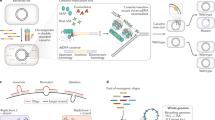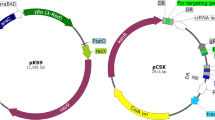Abstract
Red/ET recombineering is primarily mediated by the E. coli recombinase pair Redα/Redβ from λ phage or RecE/RecT from Rac prophage, which is applied in E. coli and also closely related Gram-negative bacteria for efficient genome editing. However, some distant bacterial species like Burkholderiales strains require host-specific Redα/Redβ recombinase pair for highly efficient genome editing. A pair of recombinases Redαβ7029 from the Burkholderiales strain DSM 7029, recently identified as Schlegelella brevitalea, were identified for efficient genetic manipulation in the native strain and several other Burkholderiales strains. In this chapter, we describe a detailed protocol for genome engineering in Burkholderiales strains via the Redγ-Redαβ7029 recombineering and Cre/loxP site-specific recombination.
Access this chapter
Tax calculation will be finalised at checkout
Purchases are for personal use only
Similar content being viewed by others
References
Depoorter E, Bull MJ, Peeters C, Coenye T, Vandamme P, Mahenthiralingam E (2016) Burkholderia: an update on taxonomy and biotechnological potential as antibiotic producers. Appl Microbiol Biotechnol 100:5215–5229
Zhang W, Du L, Qu Z, Zhang X, Li F, Li Z, Qi F, Wang X, Jiang Y, Men P, Sun J, Cao S, Geng C, Qi F, Wan X, Liu C, Li S (2019) Compartmentalized biosynthesis of mycophenolic acid. Proc Natl Acad Sci U S A 116:13305–13310
Partida-Martinez LP, Groth I, Schmitt I, Richter W, Roth M, Hertweck C (2007) Burkholderia rhizoxinica sp. nov. and Burkholderia endofungorum sp. nov., bacterial endosymbionts of the plant-pathogenic fungus Rhizopus microsporus. Int J Syst Evol Microbiol 57:2583–2590
Esmaeel Q, Pupin M, Kieu NP, Chataigne G, Bechet M, Deravel J, Krier F, Hofte M, Jacques P, Leclere V (2016) Burkholderia genome mining for nonribosomal peptide synthetases reveals a great potential for novel siderophores and lipopeptides synthesis. Microbiol Open 5:512–526
Minowa Y, Araki M, Kanehisa M (2007) Comprehensive analysis of distinctive polyketide and nonribosomal peptide structural motifs encoded in microbial genomes. J Mol Biol 368:1500–1517
Hidalgo-Cantabrana C, Goh YJ, Barrangou R (2019) Characterization and repurposing of type I and type II CRISPR-Cas systems in bacteria. J Mol Biol 431:21–33
Quin MB, Flynn CM, Schmidt-Dannert C (2014) Traversing the fungal terpenome. Nat Prod Rep 31:1449–1473
Zhang MQ, Gaisser S, Nur EAM, Sheehan LS, Vousden WA, Gaitatzis N, Peck G, Coates NJ, Moss SJ, Radzom M, Foster TA, Sheridan RM, Gregory MA, Roe SM, Prodromou C, Pearl L, Boyd SM, Wilkinson B, Martin CJ (2008) Optimizing natural products by biosynthetic engineering: discovery of nonquinone Hsp90 inhibitors. J Med Chem 51:5494–5497
Zhang Y, Muyrers JP, Rientjes J, Stewart AF (2003) Phage annealing proteins promote oligonucleotide-directed mutagenesis in Escherichia coli and mouse ES cells. BMC Mol Biol 4:1
Weber T, Charusanti P, Musiol-Kroll EM, Jiang X, Tong Y, Kim HU, Lee SY (2015) Metabolic engineering of antibiotic factories: new tools for antibiotic production in actinomycetes. Trends Biotechnol 33:15–26
Bunny K, Liu J, Roth J (2002) Phenotypes of lexA mutations in Salmonella enterica: evidence for a lethal lexA null phenotype due to the Fels-2 prophage. J Bacteriol 184:6235–6249
Wei D, Wang M, Shi J, Hao J (2012) Red recombinase assisted gene replacement in Klebsiella pneumoniae. J Ind Microbiol Biotechnol 39:1219–1226
Baltz RH, Miao V, Wrigley SK (2005) Natural products to drugs: daptomycin and related lipopeptide antibiotics. Nat Prod Rep 22:717–741
Fais T, Delmas J, Barnich N, Bonnet R, Dalmasso G (2018) Colibactin: more than a new bacterial toxin. Toxins 10:E151
Wang ZJ, Zhou H, Zhong G, Huo L, Tang YJ, Zhang Y, Bian X (2020) Genome mining and biosynthesis of primary amine-acylated desferrioxamines in a marine gliding bacterium. Org Lett 22:939–943
Knaggs AR (2003) The biosynthesis of shikimate metabolites. Nat Prod Rep 20:119–136
Eichner S, Knobloch T, Floss HG, Fohrer J, Harmrolfs K, Hermane J, Schulz A, Sasse F, Spiteller P, Taft F, Kirschning A (2012) The interplay between mutasynthesis and semisynthesis: generation and evaluation of an ansamitocin library. Angew Chem 51:752–757
Derbise A, Lesic B, Dacheux D, Ghigo JM, Carniel E (2003) A rapid and simple method for inactivating chromosomal genes in Yersinia. FEMS Immunol Med Microbiol 38:113–116
van Kessel JC, Hatfull GF (2007) Recombineering in Mycobacterium tuberculosis. Nat Methods 4:147–152
van Kessel JC, Hatfull GF (2008) Efficient point mutagenesis in mycobacteria using single-stranded DNA recombineering: characterization of antimycobacterial drug targets. Mol Microbiol 67:1094–1107
van Pijkeren JP, Britton RA (2012) High efficiency recombineering in lactic acid bacteria. Nucleic Acids Res 40:e76
Xin Y, Guo T, Mu Y, Kong J (2017) Identification and functional analysis of potential prophage-derived recombinases for genome editing in Lactobacillus casei. FEMS Microbiol Lett 364
Dong H, Tao W, Gong F, Li Y, Zhang Y (2014) A functional recT gene for recombineering of Clostridium. J Biotechnol 173:65–67
Kang Y, Norris MH, Wilcox BA, Tuanyok A, Keim PS, Hoang TT (2011) Knockout and pullout recombineering for naturally transformable Burkholderia thailandensis and Burkholderia pseudomallei. Nat Protoc 6:1085–1104
Li JW, Vederas JC (2009) Drug discovery and natural products: end of an era or an endless frontier? Science 325:161–165
Wang X, Zhou H, Chen H, Jing X, Zheng W, Li R, Sun T, Liu J, Fu J, Huo L, Li YZ, Shen Y, Ding X, Müller R, Bian X, Zhang Y (2018) Discovery of recombinases enables genome mining of cryptic biosynthetic gene clusters in Burkholderiales species. Proc Natl Acad Sci U S A 115:E4255–E4263
Zheng W, Wang X, Zhou H, Zhang Y, Li A, Bian X (2020) Establishment of recombineering genome editing system in Paraburkholderia megapolitana empowers activation of silent biosynthetic gene clusters. Microb Biotechnol 13:397–405
Chen H, Zhou H, Sun T, Xu J, Tu Q, Yang J, Zhang Y, Bian X (2020) Identification of holrhizins E-Q reveals the diversity of nonribosomal lipopeptides in Paraburkholderia rhizoxinica. J Nat Prod 83:537–541
Tang B, Yu Y, Zhang Y, Zhao G, Ding X (2015) Complete genome sequence of the glidobactin producing strain [Polyangium] brachysporum DSM 7029. J Biotechnol 210:83–84
Fu J, Bian X, Hu S, Wang H, Huang F, Seibert PM, Plaza A, Xia L, Müller R, Stewart AF, Zhang Y (2012) Full-length RecE enhances linear-linear homologous recombination and facilitates direct cloning for bioprospecting. Nat Biotechnol 30:440–446
Winn M, Fyans JK, Zhuo Y, Micklefield J (2016) Recent advances in engineering nonribosomal peptide assembly lines. Nat Prod Rep 33:317–347
Acknowledgments
This work was supported by the National Key R&D Program of China (2017YFD0201400), the National Natural Science Foundation of China (31670098, 31670097), Shandong Provincial Natural Science Foundation (ZR2019JQ11), China Postdoctoral Science Foundation Grant (No.2019M652373), the Recruitment Program of Global Experts (1000 Plan), and the Qilu Youth Scholar Startup Funding of SDU.
Author information
Authors and Affiliations
Corresponding authors
Editor information
Editors and Affiliations
Rights and permissions
Copyright information
© 2022 Springer Science+Business Media, LLC, part of Springer Nature
About this protocol
Cite this protocol
Wang, X., Liu, J., Zheng, W., Zhang, Y., Bian, X. (2022). Recombineering-Mediated Genome Editing in Burkholderiales Strains. In: Reisch, C.R. (eds) Recombineering. Methods in Molecular Biology, vol 2479. Humana, New York, NY. https://doi.org/10.1007/978-1-0716-2233-9_3
Download citation
DOI: https://doi.org/10.1007/978-1-0716-2233-9_3
Published:
Publisher Name: Humana, New York, NY
Print ISBN: 978-1-0716-2232-2
Online ISBN: 978-1-0716-2233-9
eBook Packages: Springer Protocols




